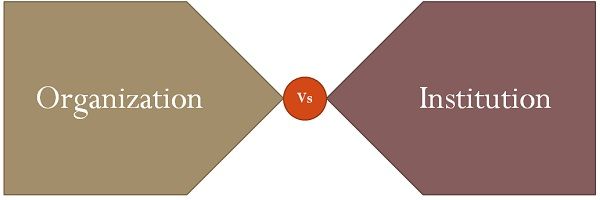 Organization means a systematically organized collection of people, with a common goal and identity associated with an external environment, like a business entity or a government department. It is often misconstrued with the institution, which encompasses an entity, with a high degree of sustainability, that can be seen as an indispensable part of the large society or community.
Organization means a systematically organized collection of people, with a common goal and identity associated with an external environment, like a business entity or a government department. It is often misconstrued with the institution, which encompasses an entity, with a high degree of sustainability, that can be seen as an indispensable part of the large society or community.
The term institution is commonly used for the place of knowledge, i.e. an entity which delivers information or imparts education to those who need it. On the other hand, an organization can be any entity established to fulfil the commercial, social, political or some other purpose.
The article presented to you will clear your understanding on the difference between organization and institution, so take a read.
Content: Organization Vs Institution
Comparison Chart
| Basis for Comparison | Organization | Institution |
|---|---|---|
| Meaning | An organization is an assemblage of people who unite to undertake a common goal, led by a person or a group thereon. | An institution is described a form of organization, which is set up for an educational, religious, social or professional cause. |
| Administration | Centralized or Decentralized | Decentralized |
| Governing factor | Rules and Regulations | Customs and Values |
| Existence | It has a life cycle. | It is long lasting. |
| Purpose | To earn money, or provide service to the members etc. | To deliver knowledge to the people. |
Definition of Organization
An organization is used to mean a group of people, engaged in chasing the predetermined goals or set of goals. Indeed, it is a social system that ascertains all formal relations between the activities and the members.
An organization is owned and controlled by one person or a group, who are the members, of the organization itself. The head of the organization is chosen either on a permanent or temporary basis, through voting at the annual general meeting, in which all the members of the organization participate.
It incorporates specialization and coordination of activities of the workers, wherein the roles, responsibilities and authority are assigned to the members, to undertake tasks efficiently. It includes both profit and non-profit undertaking. There are two types of organization structure:
- Formal Organization Structure
- Line Organization
- Functional Organization
- Line and Staff Organization
- Project Management Organization
- Matrix Organization.
- Informal Organization Structure
Definition of Institution
The term institution can be defined as a receptive organization, which comes into being as a result of social needs and pressures. It is a portion of a large society or community, which is forward looking in nature.
It performs those functions and activities that add value to the public at large. It has a high degree of endurance that leads to constant growth, ability to survive and adapt various pressures and pulls in order to move towards the future along with the effect on the environment to which the institution belongs.
The internal structures of the institution exhibit and protects the frequently held norms and values of the society. It plays the role of change inducing and change protecting agent, that protects positive values and create new ones that are required for the sustenance of the society.
Key Differences Between Organization and Institution
The differences between organization and institution are explained hereunder:
- An organization is a systematic collection of people, who work together for achieving the desired end, under a common identity. Conversely, an institution is an establishment, that is dedicated to promoting a specific cause that can be educational, professional, social, etc.
- The structure of an organization can be centralised – where power lies in the hands of the supreme authority, or decentralised – where the power is disseminated. On the other extreme, an institution has a decentralised structure, wherein power is spread to various levels of management.
- An organization is governed by rules, regulations and policies, whereas customs and values are the regulating factors of an institution.
- An organization has a certain life cycle, i.e. they have birth, growth, maturity and decay. In contrast, an institution is enduring in the sense that they have the capacity of constantly growing, overcoming ability and adapting itself to extreme conditions, to take a step towards future.
- The primary purpose of an organization is to earn money or provide services to the members. As against, the main objective of an institution is to impart education or knowledge to the users.
Conclusion
All the institutions are organizations first, as it is the initial step of the institution building process. There are only a handful of organizations, that survive, grow and adapt themselves to reach the status of the institution. The basic objective of an organization is to maintain the internal order of the organization along with the effectiveness in the achievement of desired ends. However, when it comes to the institution, it goes beyond the goals of the organization.






Peter Lau Torst Nielsen says
Thanks very useful.
Lillian says
Very useful, Could you provide any citations?
RBrant says
Yes! Great insight…concur with above comment. Citations would be very helpful!
Keith says
Very helpful especially in learning politics.
Leona M. Kalima says
When does an organization turn into a institution? What if the agency & /or organization been in operation for 40 years. is a off-shoot of a government structure? Serves a specific ethnicity? Has political influences and legislation? Has granting programs? Not under a union organized entity?
Rexcel Cariaga says
Thank you for this!!
Patricio says
Excellent, short and clear. Perhaps for a normal person organization and institution are basically the same thing. But for us who are going to be teachers, it is important to understand and be clear about the differences that exist in them.
Mai-Ephata says
very educative.
Aaditya Chauhan says
good work, the info you gave was useful. Thanks